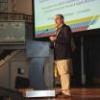With the COVID-19 pandemic presenting an ongoing global challenge, Xiche Hu’s lab at the University of Toledo is taking a closer look at the mutations of the coronavirus.
For more than 20 years, Hu’s lab has been researching an issue known as molecular recognition, which is how two molecules locate each other, and bind together to perform a biological function. When the COVID-19 pandemic started, Hu wondered if his molecular recognition expertise could help scientists understand how the coronavirus identifies the right receptors to bind to in the human body to trigger infection.





